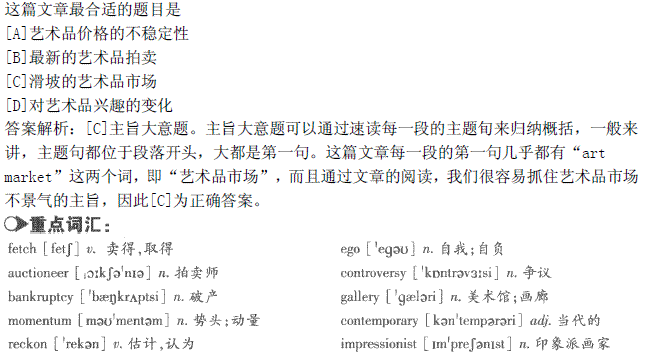第1题:
第2题:
Which of the following statements is NOT true?( )
[A] Sales of contemporary art fell dramatically from 2007 to 2008.
[B] The art market surpassed many other industries in momentum.
[C] The art market generally went downward in various ways.
[D] Some art dealers were awaiting better chances to come.
第3题:
A.Robert Browning
B.Samuel Johnson
C.Thomas Hardy
D.Oscar Wilde
第4题:
第5题:
第6题:
In the years after the Civil War most American painters received their training in Europe, the majority studying in the French schools at Paris or Barbizon, and a smaller number in Germany at Munich(慕尼黑) and Dusseldorf(杜塞尔多夫). The teaching of the Barbizon school, which stressed the use of color and the creation of an impression or a mood, influenced many American artists. One group of American painters, led by James McNeill Whistler and John Singer Sargent, expatriated(移居国外) themselves from the American scene and settled in Europe. Whistler, who is often ranked as the greatest genius(天才) in the history of American art, was a versatile(多才多艺的) and industrious(勤奋的) artist who was equally proficient(熟练的) in several media-oil, watercolor, etching(铜版画)-and with several themes-portraits and his so-called "nocturnes(夜景画)", impressionistic sketches(印象画) of moonlight on water and other scenes. He was one of the first to appreciate the beauty of Japanese color prints and to introduce Oriental concepts into Western art.
1. For a period after the Civil War, the majority of American painters ____.
A、was influenced by the Barbizon school
B、painted in the impressionist style
C、studied art in Europe
D、used striking color in their work
2. According to the passage, one group of American painters ____.
A、left America never to return
B、turned their back on the American art tradition
C、copied the style. of Whistler and Sargent
D、were unaffected by the European style. of painting
3. From the passage we are led to believe that Whistler ____.
A、did much of his painting at night
B、produced a large number of pictures
C、combined several media and themes in his paintings
D、was most proficient in impressionistic sketches
4. According to the passage, Whistler was one of the first Western painters to ____.
A、use Japanese ideas in his own work
B、become interested in Japanese printing
C、admire Japanese oil paintings
D、start producing Japanese sketches
5. The main theme of this passage is ____.
A、Whistler's influence on Western art
B、The influence of European art on American painters
C、The influence of Oriental art on Whistler
D、The American painters' influence in Europe
参考答案:1-5:CABAB
第7题:
The most appropriate title for this text could be __.( )
[A] Fluctuation of Art Prices
[B] Up-to-date Art Auctions
[C] Art Market in Decline
[D] Shifted Interest in Arts


第8题:
.
[A] Thus a joke is laughed at for its own sake, even though there is an independent value in laughter, which lightens our lives by taking us momentarily outside ourselves. Why should not something similar be said of works of art, many of which aspire to be amusing in just the way that good jokes are?
[B] All discussion of the value of art tends, therefore, to turn from the outset in the direction of criticism: Can there be genuine critical evaluation of art, a genuine distinction between that which deserves our attention and that which does not? (And, once again, the question may be extended to objects of natural beauty.)
[C] Art is held to be a form. of education, perhaps an education of the emotions. In this case, it becomes an open question whether there might not be some more effective means to the same result. Alternatively, one may attribute a negative value to art, as Plato did in his Republic, arguing that art has a corrupting or diseducative effect on those exposed to it.
[D] Artistic appreciation, a purely personal matter, calls for appropriate means of expression. Yet, it is before anything a process of “cultivation”, during which a certain part of one’s “inner self” is “dug out” and some knowledeg of the outside world becomes its match.
[E] If I am amused it is for a reason, and this reason lies in the object of my amusement. We thus begin to think in terms of a distinction between good and bad reasons for laughter. Amusement at the wrong things may seem to us to show corruption of mind, cruelty, or bad taste; and when it does so, we speak of the object as not truly amusing, and feel that we have reason on our side.
[F] Such thinkers and writers believe that art is not only an end in itself but also a sufficient justification of itself. They also hold that in order to understand art as it should be understood, it is necessary to put aside all interests other than an interest in the work itself.
本题考核的知识点是:上下文内容的衔接。
本题空格出现在第一段末。第一段前两句提出了两种艺术价值理论:外在理论和内在理论。空格处的上一句,即第三句和空格处后的第一句,即第二段第一句都是对外在理论的讨论。所以,空格处的内容应该与上下文一致,也对外在价值理论予以讨论。选项[C]是关于艺术对于艺术欣赏者的影响,属于外在价值理论的观点,且恰好是对其上一句的阐释。
第9题:
第10题: